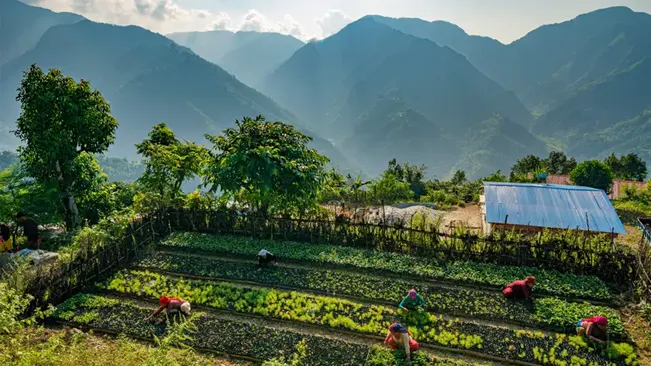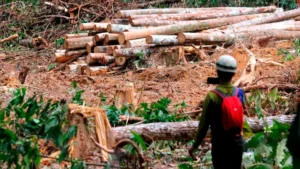Economic Impact of Forestry Programs and Policies
- August 8, 2024
- 0 comment
Forests play a crucial role in the global ecosystem, providing raw materials, maintaining biodiversity, regulating the climate, and supporting the livelihoods of millions. The economic impact of forestry programs and policies extends beyond the direct benefits of timber and non-timber products. Understanding the multifaceted economic implications of forestry initiatives is essential for crafting policies that promote sustainable development while maximizing economic benefits.
Table of Content
- Economic Impact of Forestry Programs
- Role of Forestry Policies in Economic Growth
- Sustainable Forestry Practices
- Forestry Programs and Rural Development
- Biodiversity Conservation and Economic Value
- Forestry Programs and Climate Change Mitigation
- International Trade and Forestry Policies
- Economic Challenges in Forestry Programs
- Investment in Forestry Sector
- Conclusion
- Frequently Asked Questions
Economic Impact of Forestry Programs
Forestry programs significantly contribute to employment creation and income generation. These programs often provide direct employment opportunities in forest management, conservation efforts, and timber production.
Additionally, they generate indirect employment in industries such as transportation, manufacturing, and tourism. By creating jobs, forestry programs help reduce poverty and enhance the economic stability of communities dependent on forest resources.

Employment Creation
Forestry programs can generate substantial employment, both directly and indirectly. Direct employment includes jobs in:
- Tree planting
- Forest management
- Conservation activities
- Logging operations
Indirect employment arises from related industries like:
- Sawmills
- Paper mills
- Furniture manufacturing
For instance, community-based forestry programs in countries like Nepal and Tanzania have demonstrated significant job creation, contributing to local economies.
Income Generation
Forestry programs can be a vital source of income for rural communities. Sustainable management of forest resources ensures a continuous supply of timber and non-timber products, which can be sold in local and international markets.
For example, non-timber forest products (NTFPs) like medicinal plants, resins, and fruits provide additional income streams for forest-dependent communities, enhancing their economic resilience.
Role of Forestry Policies in Economic Growth
Effective forestry policies are essential for maximizing the economic benefits of forest resources. These policies establish frameworks that govern the sustainable management, utilization, and conservation of forests, ensuring long-term economic growth.

Policy Frameworks
Forestry policies create the legal and institutional frameworks necessary for sustainable forest management. These frameworks include regulations on logging practices, reforestation requirements, and conservation measures.
For example, the Forest Stewardship Council (FSC) certification program sets standards for responsible forest management, promoting economic benefits through access to premium markets for certified timber.
Economic Growth Metrics
Forestry policies contribute to economic growth by fostering sustainable use of forest resources. Metrics such as GDP contribution from forestry, employment rates in the sector, and income levels of forest-dependent communities are indicators of the economic impact of these policies.
Countries with robust forestry policies, like Finland and Canada, show higher economic returns from their forest sectors, demonstrating the effectiveness of well-designed policies.
Sustainable Forestry Practices
Sustainable forestry practices are essential for ensuring long-term economic benefits. These practices balance the need for economic development with environmental conservation, promoting the health and productivity of forest ecosystems.
Long-Term Economic Benefits
Sustainable forestry practices provide long-term economic benefits by ensuring the continuous availability of forest resources. Practices such as selective logging, agroforestry, and reforestation help maintain forest health and productivity.
This, in turn, supports industries reliant on forest resources, ensuring steady economic returns. For example, sustainable logging practices in the Amazon have been shown to maintain forest cover while providing economic benefits to local communities.
Case Studies
Several case studies highlight the economic benefits of sustainable forestry practices. In Costa Rica, for example, sustainable forestry initiatives have not only conserved biodiversity but also boosted ecotourism, generating significant revenue for the local economy. Similarly, in Sweden, sustainable forest management practices have ensured the long-term viability of the timber industry, contributing to national economic growth.
Forestry Programs and Rural Development
Forestry programs play a critical role in rural development by enhancing infrastructure, providing employment, and supporting local economies. These programs are particularly important in remote and rural areas where alternative sources of income and employment are limited.
Impact on Rural Communities
Forestry programs can transform rural communities by creating jobs, improving infrastructure, and fostering economic development. Community-based forestry initiatives empower local populations by involving them in forest management, ensuring that the benefits of forestry programs are equitably distributed. For instance, in India, the Joint Forest Management (JFM) program has engaged local communities in forest conservation and management, leading to improved livelihoods and economic development.

Infrastructure Development
Investment in forestry programs often leads to the development of infrastructure such as roads, schools, and healthcare facilities in rural areas. These improvements enhance the quality of life for rural residents and stimulate economic activity. For example, in African countries like Ghana and Ethiopia, forestry programs have contributed to the construction of essential infrastructure, promoting overall rural development.

Biodiversity Conservation and Economic Value
Biodiversity conservation is a vital aspect of forestry programs, delivering significant economic benefits through various ecosystem services. By conserving biodiversity, we enhance ecosystem resilience, which is crucial for sustaining economic activities that rely on forest resources. Forests provide a range of essential services, including water regulation, soil protection, and climate regulation, all of which hold substantial economic value.
These services not only support agriculture and reduce the risk of natural disasters but also contribute to overall human well-being. For example, the preservation of mangrove forests in Southeast Asia has been instrumental in protecting against coastal erosion and storm surges, thereby safeguarding local economies.
Investing in biodiversity conservation within forestry programs can yield impressive economic returns. Protected areas and conservation initiatives attract tourism, create jobs, and generate revenue, which can significantly benefit local communities.
The establishment of national parks and wildlife reserves in countries like South Africa and Costa Rica has led to a remarkable boost in ecotourism, showcasing the economic potential of preserving natural habitats. By prioritizing biodiversity conservation, countries can not only protect their ecosystems but also enhance their economic resilience and sustainability.
Forestry Programs and Climate Change Mitigation
Forestry programs play a vital role in mitigating climate change by enhancing carbon sequestration and reducing greenhouse gas emissions. These efforts also provide economic incentives through carbon credits and international funding mechanisms.

Carbon Sequestration
Forests act as carbon sinks, absorbing carbon dioxide from the atmosphere and mitigating climate change. Forestry programs that promote reforestation and afforestation enhance this carbon sequestration capacity, providing environmental and economic benefits. For example, the REDD+ (Reducing Emissions from Deforestation and Forest Degradation) program incentivizes developing countries to protect and restore forests, offering economic rewards for carbon sequestration.
Economic Incentives
Economic incentives for climate change mitigation through forestry programs include carbon credits, which can be traded in carbon markets. These incentives provide financial support for sustainable forest management practices. Countries like Brazil and Indonesia have benefited from carbon credit schemes, receiving substantial funding for their reforestation efforts.
International Trade and Forestry Policies
Forestry policies influence international trade by regulating the export and import of forest products. Trade agreements and global market dynamics significantly impact the economic outcomes of forestry programs.
Global Market Influence
The global market for forest products is influenced by forestry policies that ensure sustainable management and certification. Access to international markets for sustainably sourced timber and non-timber products can enhance economic benefits. For instance, the European Union’s Forest Law Enforcement, Governance and Trade (FLEGT) action plan promotes legal timber trade, providing market access and economic opportunities for compliant countries.
Trade Agreements
Trade agreements play a crucial role in shaping the economic impact of forestry policies. Agreements that include provisions for sustainable forest management and conservation can enhance economic benefits by ensuring access to premium markets. The North American Free Trade Agreement (NAFTA), for example, includes environmental provisions that promote sustainable forestry practices, benefiting the economies of member countries.
Economic Challenges in Forestry Programs
Despite the potential economic benefits, forestry programs face several challenges that can hinder their effectiveness. Financial constraints are a major issue, as limited funding and investment make it difficult to secure adequate resources for sustainable forest management, conservation, and infrastructure development. Innovative financing mechanisms, such as public-private partnerships and international funding, are essential for overcoming these financial barriers.
Additionally, the forestry sector is vulnerable to market fluctuations, which can affect the economic viability of forestry programs. Changes in global demand for forest products, price volatility, and trade restrictions can significantly impact the income generated from forestry activities. To mitigate these risks, it is crucial to diversify income sources and develop resilient market strategies. Addressing these challenges is vital for maximizing the economic impact of forestry initiatives.
Investment in Forestry Sector
Investment in the forestry sector is crucial for promoting sustainable development and maximizing economic benefits. Both public and private investments play a vital role in supporting forestry programs and policies.

Public and Private Investments
Public investment in forestry programs is essential for creating the infrastructure and institutional frameworks necessary for sustainable forest management. Key areas of public investment include:
- Research: Funding for scientific research to improve forest management practices and understand ecological impacts.
- Conservation Efforts: Financial support for initiatives aimed at preserving biodiversity and protecting endangered species.
- Community-Based Initiatives: Investments that empower local communities to manage and benefit from forest resources sustainably.
Private investment, on the other hand, drives innovation, enhances productivity, and expands market opportunities. Important aspects of private investment include:
- Innovation: Funding for new technologies and methods to increase efficiency and sustainability in forest management.
- Market Expansion: Investments aimed at developing new markets for forest products and services, including ecotourism and non-timber forest products.
- Public-Private Partnerships: Collaborations that combine public oversight with private sector efficiency and innovation to maximize the economic impact of forestry programs.
Economic Returns
Investments in the forestry sector yield significant economic returns through the sustainable management and utilization of forest resources. These returns include:
- Revenue from Timber Products: Sustainable logging practices ensure a continuous supply of high-quality timber for construction, furniture, and paper industries.
- Revenue from Non-Timber Products: Products like medicinal plants, resins, fruits, and nuts provide additional income streams for communities and businesses.
- Ecotourism: Forests attract tourists for activities like hiking, bird watching, and cultural tours, generating income for local economies.
- Ecosystem Services: Forests provide valuable services such as carbon sequestration, water regulation, and soil protection, which have economic benefits for agriculture, urban areas, and overall climate stability.
For example, investment in sustainable forest management in countries like Malaysia and Brazil has generated substantial economic benefits, supporting national development goals while preserving vital ecosystems. These investments not only bolster the economy but also ensure that forest resources remain available for future generations.
By combining public and private investments, the forestry sector can achieve a balance between economic growth and environmental sustainability, leading to long-term benefits for both people and the planet.
Conclusion
Forestry programs and policies have profound economic impacts that extend beyond direct financial gains from timber and non-timber products. By promoting sustainable practices, creating jobs, supporting rural development, and mitigating climate change, these programs contribute to broader economic stability and growth.
Addressing the challenges and maximizing the opportunities within the forestry sector requires continued investment, innovative policies, and collaborative efforts among stakeholders. As global priorities shift towards sustainability and environmental conservation, the economic role of forestry programs and policies will become increasingly significant, driving forward both ecological and economic benefits.
Frequently Asked Questions
1. What are the main economic impacts of forestry programs?
Forestry programs generate employment, support local economies, and provide income through sustainable timber and non-timber products.
2. How do forestry policies contribute to economic growth?
Effective forestry policies ensure sustainable management, enhance GDP contributions, and create jobs, fostering long-term economic growth.
3. What are sustainable forestry practices?
Sustainable practices include selective logging, reforestation, and ecosystem management to maintain forest health and economic viability.
4. How do forestry programs support rural development?
They create jobs, improve infrastructure, and empower communities, leading to enhanced economic stability in rural areas.
5. What is the economic value of biodiversity conservation in forestry?
Conserving biodiversity supports ecosystem services, promotes tourism, and ensures the sustainability of economic activities dependent on forest resources.
6. How do forestry programs mitigate climate change?
By enhancing carbon sequestration and reducing emissions, forestry programs contribute to climate change mitigation and offer economic incentives like carbon credits.
7. What role does international trade play in forestry policies?
International trade, influenced by sustainable forestry policies, ensures market access for certified products and economic benefits through trade agreements.
8. What are the economic challenges in forestry programs?
Challenges include financial constraints, market fluctuations, and the need for diversified income sources and resilient market strategies.
9. How does investment impact the forestry sector?
Both public and private investments drive sustainable forest management, innovation, market expansion, and significant economic returns.
10. Why is understanding the economic impact of forestry programs important?
It helps craft policies that promote sustainable development, maximize economic benefits, and ensure the long-term viability of forest resources.
We hope this exploration of the economic impact of forestry programs and policies has given you helpful insights into the many benefits of sustainable forest management. Understanding how forestry affects the economy like creating jobs and helping with climate change is important for making effective policies and supporting long-term growth. If you have any experiences or additional thoughts on the economic impact of forestry programs, please share them in the comments below. Your input can help others see the importance of sustainable forestry and its role in global economic development. Don’t forget to share this article with friends and colleagues who are interested in forestry to expand the conversation and highlight the importance of sustainable forestry practices.

James Wilson
Forestry AuthorJames Wilson has over 15 years of experience in forestry economics, specializing in sustainable practices, investment opportunities, and financial management. He has contributed to notable publications like "Forestry Today" and "EcoFinance Journal" and is known for providing practical and insightful advice. With a degree in Environmental Economics, James stays updated through continuous learning and active participation in industry discussions. Outside work, he enjoys hiking and nature photography, bringing a well-rounded perspective to his professional role.








Leave your comment